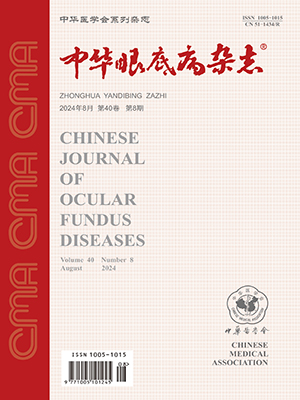| 1. |
Markowitz Samuel N, Reyes Sophia V. Microperimetry and clinical practice: an evidence-based review[J]. Can J of Ophthalmol, 2013, 48(5): 350-357. DOI: 10.1016/j.jcjo.2012.03.004.
|
| 2. |
Diabetic Retinopathy Clinical Research Network, Browning DJ, Glassman AR, et al. Relationship between optical coherence tomography–measured central retinal thickness and visual acuity in diabetic macular edema[J]. Ophthalmology, 2007, 114(3): 525-536. DOI: 10.1016/j.ophtha.2006.06.052.
|
| 3. |
Okada K, Yamamoto S, Mizunoya S, et al. Correlation of retinal sensitivity measured with fundus-related microperimetry to visual acuity and retinal thickness in eyes with diabetic macular edema[J]. Eye, 2006, 20(7): 805. DOI: 10.1038/sj.eye.6702014.
|
| 4. |
Hatef E, Colantuoni E, Wang J, et al. The relationship between macular sensitivity and retinal thickness in eyes with diabetic macular edema[J]. Am J Ophthalmol, 2011, 152(3): 400-405. DOI: 10.1016/j.ajo.2011.02.024.
|
| 5. |
Vujosevic S, Midena E, Pilotto E, et al. Diabetic macular edema: correlation between microperimetry and optical coherence tomography findings[J]. Invest Ophthalmol Vis Sci, 2006, 47(7): 3044-3051. DOI: 10.1167/iovs.05-1141.
|
| 6. |
Carpineto P, Ciancaglini M, Di Antonio L, et al. Fundus microperimetry patterns of fixation in type 2 diabetic patients with diffuse macular edema[J]. Retina, 2007, 27(1): 21-29. DOI: 10.1097/01.iae.0000256658.71864.ca.
|
| 7. |
杨晓璐, 邹海东, 许迅, 等.不同类型糖尿病黄斑水肿患者视网膜敏感度和视力与黄斑厚度相关性分析[J]. 中华眼科杂志, 2013, 49(12): 1081-1088. DOI: 10.3760/cma.j.issn.0412-4081.2013.12.006.Yang XL, Zou HD, Xu X, et al. Correlation of retinal sensitivity, visual acuity and central macular thickness in different types of diabetic macular edema[J]. Chin J Ophthalmol, 2013, 49(12): 1081-1088. DOI: 10.3760/cma.j.issn.0412-4081.2013.12.006.
|
| 8. |
Deák GG, Bolz M, Ritter M, et al. A systematic correlation between morphology and functional alterations in diabetic macular edema[J]. Invest Ophthalmol Vis Sci, 2010, 51(12): 6710-6714. DOI: 10.1167/iovs.09-5064.
|
| 9. |
Soliman W, Hasler P, Sander B, et al. Local retinal sensitivity in relation to specific retinopathy lesions in diabetic macular oedema[J]. Acta Ophthalmol, 2012, 90(3): 248-253. DOI: 10.1111/j.1755-3768.2010.01912.x.
|
| 10. |
Otani T, Kishi S, Maruyama Y. Patterns of diabetic macular edema with optical coherence tomography[J]. Am J Ophthalmol, 1999, 127(6): 688-693. DOI: https://doi.org/10.1016/S0002-9394(99)00033-1.
|
| 11. |
Forte R, Cennamo G, Finelli ML, et al. Retinal micropseudocysts in diabetic retinopathy: prospective functional and anatomic evaluation[J]. Ophthalmic Res, 2012, 48(1): 6-11. DOI: 10.1159/000334618.
|
| 12. |
Kothari AR, Raman RPG, Sharma T, et al. Is there a correlation between structural alterations and retinal sensitivity in morphological patterns of diabetic macular edema?[J]. Indian J Ophthalmol, 2013, 61(5): 230-232. DOI: 10.4103/0301-4738.97081.
|
| 13. |
Velaga SB, Nittala MG, Parinitha B, et al. Correlation between retinal sensitivity and cystoid space characteristics in diabetic macular edema[J]. Indian J Ophthalmol, 2016, 64(6): 452-458. DOI: 10.4103/0301-4738.187675.
|
| 14. |
Raman R, Nittala MG, Gella L, et al. Retinal sensitivity over hard exudates in diabetic retinopathy[J]. J Ophthalmic Vis Res, 2015, 10(2): 160-164. DOI: 10.4103/2008-322X.163771.
|
| 15. |
Vujosevic S, Pilotto E, Bottega E, et al. Retinal fixation impairment in diabetic macular edema[J]. Retina, 2008, 28(10): 1443-1450. DOI: 10.1097/IAE.0b013e318183571e.
|
| 16. |
Ozdemir H, Karacorlu M, Karacorlu S. Serous macular detachment in diabetic cystoid macular oedema[J]. Acta Ophthalmol Scand, 2005, 83(1): 63-66. DOI: 10.1111/j.1600-0420.2005.00387.x.
|
| 17. |
Gaucher D, Sebah C, Erginay A, et al. Optical coherence tomography features during the evolution of serous retinal detachment in patients with diabetic macular edema[J]. Am J Ophthalmol, 2008, 145(2): 289-296. DOI: 10.1016/j.ajo.2007.09.029.
|
| 18. |
Shen Y, Liu K, Xu X. Correlation between visual function and photoreceptor integrity in diabetic macular edema: spectral-domain optical coherence tomography[J]. Curr Eye Res, 2016, 41(3): 391-399. DOI: 10.3109/02713683.2015.1019003.
|
| 19. |
Vujosevic S, Torresin T, Berton M, et al. Diabetic macular edema with and without subfoveal neuroretinal detachment: two different morphologic and functional entities[J]. Am J Ophthalmol, 2017, 181: 149-155. DOI: 10.1016/j.ajo.2017.06.026.
|
| 20. |
Rajiv R, Kiruthika S, Laxmi G, et al. Morphological and functional outcomes following modified early treatment diabetic retinopathy study laser in diabetic macular edema[J]. Oman J Ophthalmol, 2015, 8(2): 92-96. DOI: 10.4103/0974-620X.159252.
|
| 21. |
Reznicek L, Cserhati S, Seidensticker F, et al. Functional and morphological changes in diabetic macular edema over the course of anti-vascular endothelial growth factor treatment[J]. Acta Ophthalmol, 2013, 91(7): 529-536. DOI: 10.1111/aos.12153.
|
| 22. |
Malagola R, Spinucci G, Cofone C, et al. Prospective microperimetry and OCT evaluation of efficacy of repeated intravitreal bevacizumab injections for persistent clinically significant diabetic macular edema[J]. Int Ophthalmol, 2013, 33(3): 261-267. DOI: 10.1007/s10792-012-9685-3.
|
| 23. |
Vujosevic S, Berton M, Bini S, et al. Hyperreflective retinal spots and visual function after anti-vascular endothelial growth factor treatment in center-involving diabetic macular edema[J]. Retina, 2016, 36(7): 1298-1308. DOI: 10.1097/IAE.0000000000000912.
|
| 24. |
Karacorlu M, Ozdemir H, Senturk F, et al. Macular function after intravitreal triamcinolone acetonide injection for diabetic macular oedema[J]. Acta Ophthalmol, 2010, 88(5): 558-563. DOI: 10.1111/j.1755-3768.2008.01497.x.
|
| 25. |
Grenga P, Lupo S, Domanico D, et al. Efficacy of intravitreal triamcinolone acetonide in long standing diabetic macular edema: a microperimetry and optical coherence tomography study[J]. Retina, 2008, 28(9): 1270-1275. DOI: 10.1097/IAE.0b013e31817d5d1c.
|
| 26. |
Vujosevic S, Torresin T, Bini S, et al. Imaging retinal inflammatory biomarkers after intravitreal steroid and anti-VEGF treatment in diabetic macular oedema[J]. Acta ophthalmol, 2017, 95(5): 464-471. DOI: 10.1111/aos.13294.
|




